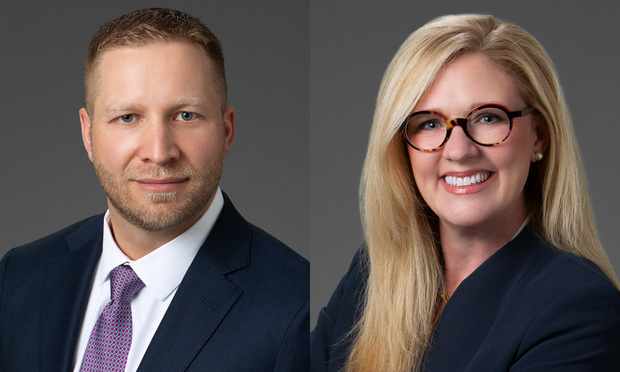 Phillip M. Aurentz (left) and Aimee P. Fagan (right), partners with Sidley Austin (Courtesy photos)
Phillip M. Aurentz (left) and Aimee P. Fagan (right), partners with Sidley Austin (Courtesy photos) A Dozen Questions To Answer Before Negotiating a Protective Order in Civil Litigation
Little creates as much havoc in civil litigation as an ill-conceived or misunderstood protective order. Aimee Fagan and Phillip Aurentz of Sidley Austin have some tips to avoid common pitfalls.
May 19, 2021 at 12:18 PM
8 minute read
Little creates as much havoc in civil litigation as an ill-conceived or misunderstood protective order. Yet many parties rush through the process of negotiating and preparing a protective order, often delegating the task to young associates with little experience in identifying and surviving the pitfalls associated with them. There is no good substitute for experience. But careful consideration of the dozen questions posed below will help avoid some of the more common rookie mistakes.
(1) How many and what confidentiality tiers are appropriate?
Protective orders often have multiple levels of protection. For example, in a three-tier order, a "Confidential" label is typically used to keep information available to all parties and their counsel but prevent disclosure to the public. A "Highly Confidential" designation may limit access to specific individuals and counsel for each party, and may be used to limit the parties' technical employees' access to core case material. A third tier, "Attorneys Eyes Only" may be used to limit disclosure to outside counsel only, or a mix of outside and in-house counsel who may be restricted from or uninvolved in business and development activities related to the underlying technologies or confidential information. A two-tier system (often "confidential" and "attorneys eyes only") may be a better solution in simpler cases, as they are generally easier to manage and less prone to the human error that may occur while designating and managing designated information.
This content has been archived. It is available through our partners, LexisNexis® and Bloomberg Law.
To view this content, please continue to their sites.
Not a Lexis Subscriber?
Subscribe Now
Not a Bloomberg Law Subscriber?
Subscribe Now
NOT FOR REPRINT
© 2025 ALM Global, LLC, All Rights Reserved. Request academic re-use from www.copyright.com. All other uses, submit a request to [email protected]. For more information visit Asset & Logo Licensing.
You Might Like
View All
Even When Witnesses Don't Tell You They're Panicking, They're Panicking

Latham Goes Global for Witness Testimony in Case for 'Fully Distributed' Freelance Platform Client

Much Ado About Andy: Should Amazon's New CEO Sit for Deposition in a Patent Case Targeting His Old Division?
Trending Stories
- 1'Didn't Notice Patient Wasn't Breathing': $13.7M Verdict Against Anesthesiologists
- 2'Astronomical' Interest Rates: $1B Settlement to Resolve Allegations of 'Predatory' Lending Cancels $534M in Small-Business Debts
- 3Senator Plans to Reintroduce Bill to Split 9th Circuit
- 4Law Firms Converge to Defend HIPAA Regulation
- 5Judge Denies Retrial Bid by Ex-U.S. Sen. Menendez Over Evidentiary Error
Who Got The Work
J. Brugh Lower of Gibbons has entered an appearance for industrial equipment supplier Devco Corporation in a pending trademark infringement lawsuit. The suit, accusing the defendant of selling knock-off Graco products, was filed Dec. 18 in New Jersey District Court by Rivkin Radler on behalf of Graco Inc. and Graco Minnesota. The case, assigned to U.S. District Judge Zahid N. Quraishi, is 3:24-cv-11294, Graco Inc. et al v. Devco Corporation.
Who Got The Work
Rebecca Maller-Stein and Kent A. Yalowitz of Arnold & Porter Kaye Scholer have entered their appearances for Hanaco Venture Capital and its executives, Lior Prosor and David Frankel, in a pending securities lawsuit. The action, filed on Dec. 24 in New York Southern District Court by Zell, Aron & Co. on behalf of Goldeneye Advisors, accuses the defendants of negligently and fraudulently managing the plaintiff's $1 million investment. The case, assigned to U.S. District Judge Vernon S. Broderick, is 1:24-cv-09918, Goldeneye Advisors, LLC v. Hanaco Venture Capital, Ltd. et al.
Who Got The Work
Attorneys from A&O Shearman has stepped in as defense counsel for Toronto-Dominion Bank and other defendants in a pending securities class action. The suit, filed Dec. 11 in New York Southern District Court by Bleichmar Fonti & Auld, accuses the defendants of concealing the bank's 'pervasive' deficiencies in regards to its compliance with the Bank Secrecy Act and the quality of its anti-money laundering controls. The case, assigned to U.S. District Judge Arun Subramanian, is 1:24-cv-09445, Gonzalez v. The Toronto-Dominion Bank et al.
Who Got The Work
Crown Castle International, a Pennsylvania company providing shared communications infrastructure, has turned to Luke D. Wolf of Gordon Rees Scully Mansukhani to fend off a pending breach-of-contract lawsuit. The court action, filed Nov. 25 in Michigan Eastern District Court by Hooper Hathaway PC on behalf of The Town Residences LLC, accuses Crown Castle of failing to transfer approximately $30,000 in utility payments from T-Mobile in breach of a roof-top lease and assignment agreement. The case, assigned to U.S. District Judge Susan K. Declercq, is 2:24-cv-13131, The Town Residences LLC v. T-Mobile US, Inc. et al.
Who Got The Work
Wilfred P. Coronato and Daniel M. Schwartz of McCarter & English have stepped in as defense counsel to Electrolux Home Products Inc. in a pending product liability lawsuit. The court action, filed Nov. 26 in New York Eastern District Court by Poulos Lopiccolo PC and Nagel Rice LLP on behalf of David Stern, alleges that the defendant's refrigerators’ drawers and shelving repeatedly break and fall apart within months after purchase. The case, assigned to U.S. District Judge Joan M. Azrack, is 2:24-cv-08204, Stern v. Electrolux Home Products, Inc.







